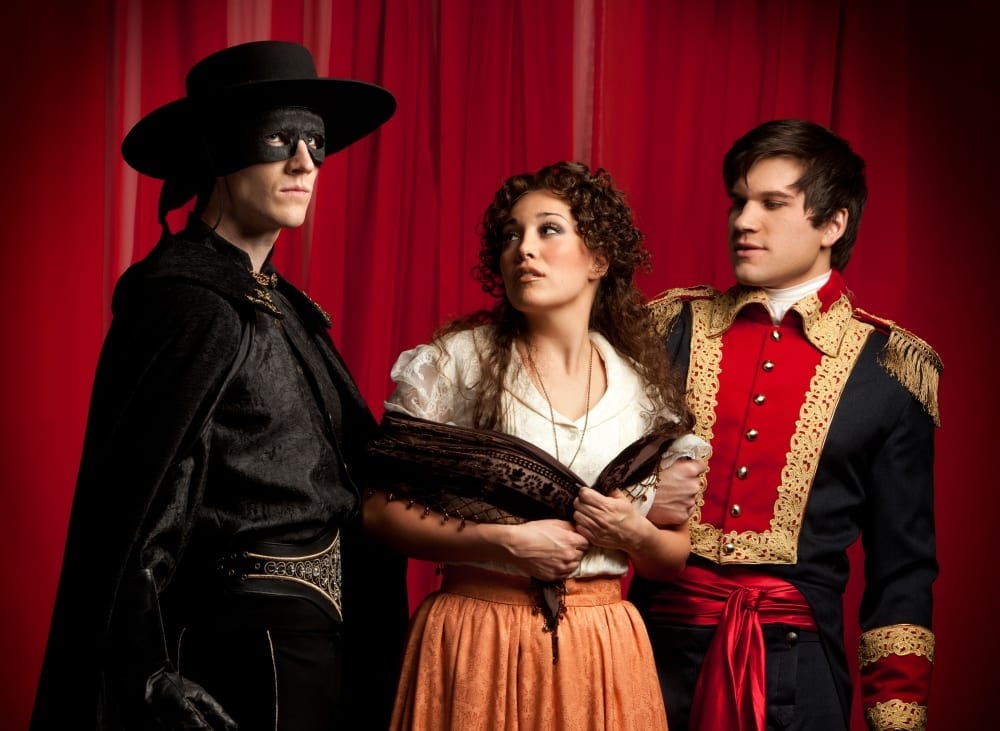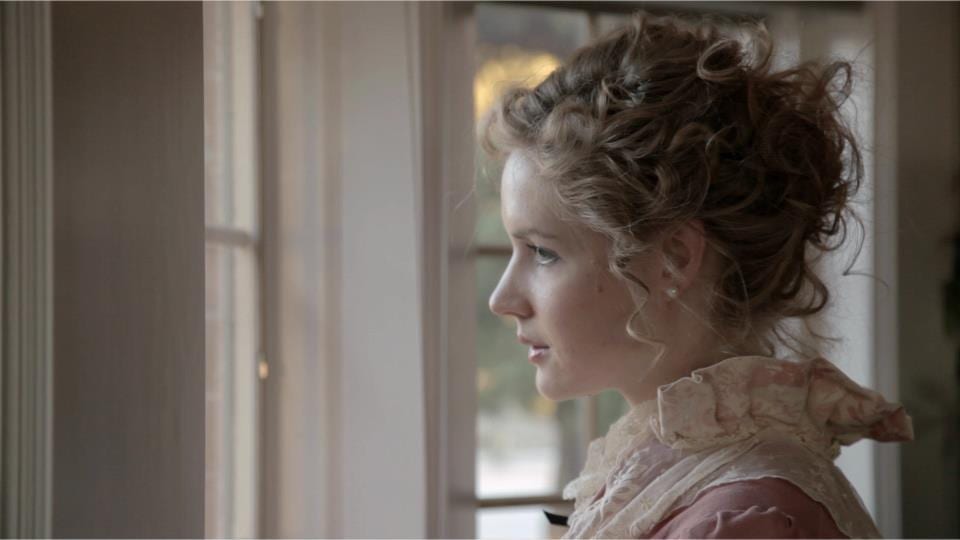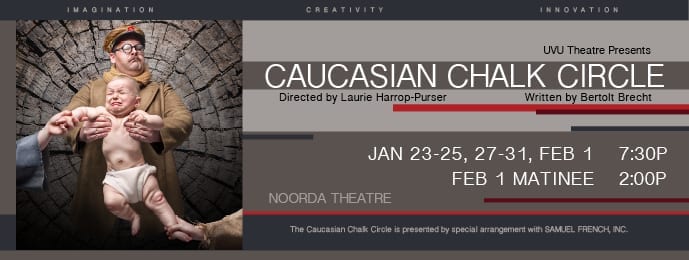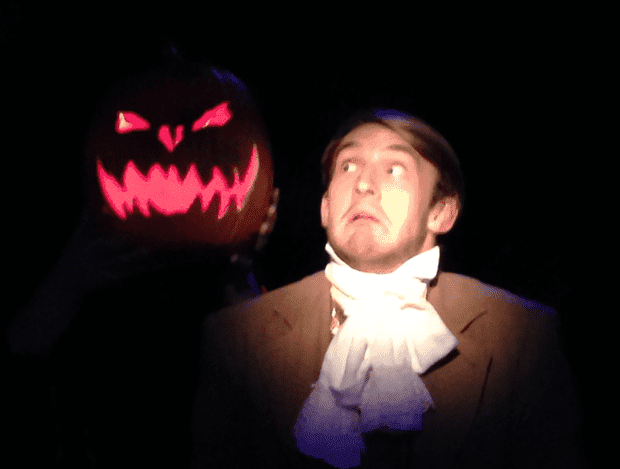WEST VALLEY — I’m really torn about this one. When I take it apart, there were a lot of great things in Hale Centre Theater’s production of Zorro The Musical. I liked the sword fighting, the beautiful costumes, and the talented performers. But, after hour one of this three-hour production, I was hanging my head in disappointment, and counting down the scenes until the end.
The story begins with Don Alejandro, who is the leader in his area of California. He has two sons and decides to leave his legacy and responsibilities to the younger. This son, Diego, refuses this appointment and leaves his family. The birthright then falls upon the older brother, Ramon, who becomes a tyrant over the people. Years pass, and Diego is located in Spain by his childhood love, Luisa. When he is informed of Ramon’s cruelty and of the death of his father, he returns to California to stop Ramon and to free the people. Diego becomes Zorro.
Stephen Clark’s story was not my favorite. The biggest issue being that I have no idea why Diego left California, and this apparently pivotal scene takes a total of five minutes to transpire. Diego’s reply in the scene gave me the impression that he expected Ramon to inherit the position, but later on, Luisa and Diego seem shocked that he does. Also, Diego and Luisa appear to be in love, but when Diego flees his home, he doesn’t acknowledge her at all. Clark offers no explanation of this departure then or later. It’s perplexing. My problems with this show lie mostly with the creators.
While in Spain, Diego joined a group of passionate and colorful gypsies. Inez (Rebecca Joy Raboy) is the queen of the gypsies and I loved her every second she was on stage. Raboy portrayed her character like lightening; her energy, wit, and her command of the audience were electrifying. Diego/Zorro was played by Casey Elliot, whom I adored in last year’s A Tale of Two Cities. He did not disappoint in this show, excelling with what he was given. I wish Elliot had been on stage more; he is a magnetic actor. He is expressive and believable, handsome, and has a wonderful voice. There is no shortage of beautiful faces and voices in this show.
Zorro delivers some rare theatrical treats. There were onstage illusions with Inez and Diego, which were so impressive. Also, there were several fire effects (Dave and Donna Johnson). Ramon has a nightmare, in which large flames come from under the stage on either side of him; it was a brilliant shock as I felt the heat from my position in the audience. Zorro’s entrances often included pyrotechnics as well.
The dancing in the show was another standout. I particularly enjoyed the wonderful flamenco dancing (Choreographers David Tinney and Solange Gomez). John Graham, Christopher Squires (awesome vocals), Victoria Greco, and Ashley Kathryn Stonebraker joined the fabulous Raboy in a exciting and unique style of dance, accentuated by flowing skirts, and heeled men’s shoes (Costumes by Tamara Clayton). They even used castanets at one point—so talented!
As the show progressed, questions arose about the script and the musical numbers, the plot became long and repetitive. It simply couldn’t hold my attention.
There was also a tricky line in this show between passion and melodrama. For example, I loved the powerful performance of “La Liberdad” by the townswomen. The men they love have been taken away by Ramon’s men, and they are grieving the injustice. They sang with vigor, they reached to the sky; their words were punctuated with stomping and clapping. It was wonderful. But these same women come off as phony and overacted in the scene “In One Day,” when their partners are about to be hanged. It was perplexing and uncomfortable for me to see what should be a great scene coming off as corny. Maybe the acting just needed to adjust to the mood of each scene; hand gestures and facial expressions could have been toned down, but that would have been up to director David Tinney, I believe. The cheesiest scene of the show was, sadly, the love scene. In a hidden cave, Zorro and Luisa are alone. So what do they do? Some crazy “Dancing With The Stars” type number that made me so, so uncomfortable. It wasn’t romantic or believable; it didn’t draw me in. And it killed me, because that was their one big chance to show some sincere chemistry. I think it was a bad choice.
Speaking of believability, the character of Ramon, played by Preston Yates, was overdone and over the top. I cringed as he raged…paused…and threw over a bench, then raged and fake slapped Luisa. I understand that Ramon is an angry/insane character, but the passion slipped into absurdity far too often. It’s probably a tough role, and I hope Yates will pleasantly surprise me in the future.
I appreciate that this is a new show, and that The Gipsy Kings and John Cameron were trying to be musically original, but I’m not sure if the melodies really work for an American audience. Zorro has been a hit in Europe, so I wondered why it wasn’t a hit with me. I enjoyed the Spanish flavor in the guitar playing, but I wonder if there were too many guitar-type runs in the singing. I enjoyed these runs during Ramon’s nightmare: they added to the feeling of unrest and confusion; but in the rest of the show, there were such varying patterns in the music that it was tough to catch a melody, or to come away remembering a song. I just couldn’t get wrapped up in most of these numbers.
There were a few exceptions, though. I really got excited when Elliot started singing “Hope.” It was a good melody and he sounded wonderful. But then the tempo sped up quite a bit, with Diego barely spitting the words out at pace, and I deflated. I liked half of the song. Other numbers that I like half of: “Baila me,” “Remember,” and “Bamboleo.” I don’t know that there was anything lyrically wrong with the songs; it seemed mostly to be melodic and rhythmic issues that kept me from feeling connected to or engaged in them. (I think the same can be said for the rest of the play. I didn’t hate any of the dialogue, but something about the way it was pieced together didn’t gel.) A musical moment that I truly enjoyed came near the end, when Luisa (Megan Lynn Heaps) is mournfully preparing for her wedding, and she sings a song called, “The Man Behind the Mask.” I enjoyed this scene very much. Heaps’ voice was lovely; the staging was simple, beautiful, and sincere. I finally felt connected to the show. The phrase, “The man behind the mask,” is a good one, and I wish the writers had used it more and earlier in the show.
I don’t love Zorro The Musical; I didn’t understand the story structure and I couldn’t fall in love with the songs. But I feel like the cast and crew at Hale made a decent product out of pretty iffy ingredients. I admire their talent and their obvious passion for this show. I thank Hale Centre Theater for the quality cast and the fun surprises.







